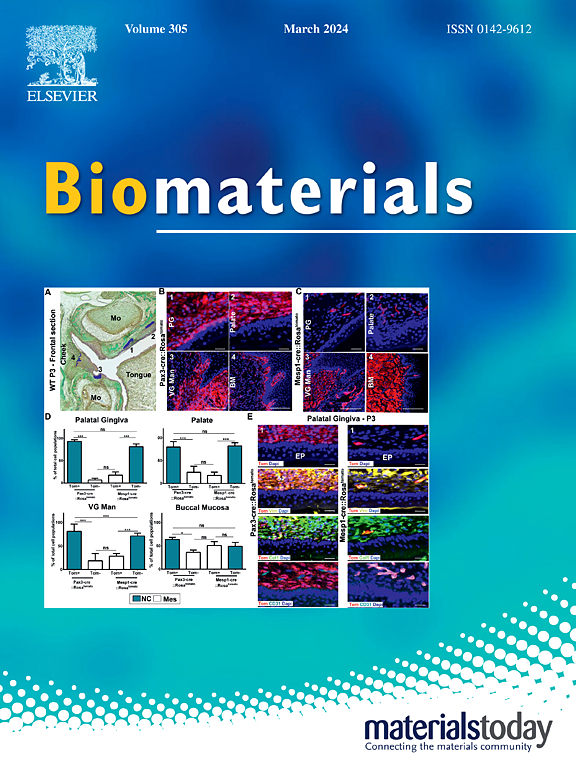金属-酚醛网络通过生成一氧化氮和糖萼功能化来辅助构建多层内皮-模拟聚电解质涂层
IF 12.8
1区 医学
Q1 ENGINEERING, BIOMEDICAL
引用次数: 0
摘要
在心血管支架内内皮化过程中,需要应用模拟内皮涂层来建立有利于促进内皮化的微环境,从而降低支架内血栓形成和再狭窄的风险。在这项研究中,我们在血管支架上构建了一种由金属酚网络(mpn)辅助的模拟内皮涂层。该功能组件通过一层一层的自组装技术集成,其中带正电的聚乙烯亚胺,带负电的透明质酸(HA),以及由表没食子儿茶素没食子酸酯和Cu组成的mpn作为三明治辅助中间层。铜催化释放的血管活性一氧化氮(NO)与糖萼表面的主要成分HA修饰使血管支架具有类似天然内皮细胞的保护功能。阳离子-阴离子电解质和多酚的存在通过静电吸附、氢键、π -π堆叠和苯酚-醛胺共价交联等多种相互作用增强了涂层的负载、稳定性和均匀性。系统的体外和体内研究表明,该涂层可显著降低血小板粘附活化和血栓形成,选择性促进内皮细胞增殖和调节平滑肌细胞行为,并通过NO催化释放和糖萼功能化的协同作用减轻炎症反应。体内支架植入实验表明,与裸支架相比,该涂层加速支架内皮化,抑制血管内膜增生。植入后3个月,涂层支架的管腔损失率仅为裸支架的三分之一。总的来说,mpns辅助构建多层内皮模拟聚电解质涂层,采用双模态策略,结合糖萼功能化接触治疗和NO生成气体治疗,为下一代支架的开发提供了创新的见解。该方法可作为一种通用的表面修饰策略,以提高植入式心血管装置的生物相容性。本文章由计算机程序翻译,如有差异,请以英文原文为准。
Metal-phenolic networks assisted construction of multi-layered endothelium-mimetic polyelectrolyte coating with nitric oxide generation and glycocalyx functionalization
During cardiovascular-stent endothelialization, application of an endothelium-mimetic coating is desirable to establish a conducive microenvironment that promotes endothelialization, thereby reducing the risks of in-stent thrombosis and restenosis. In this study, we construct an endothelium-mimetic coating on vascular stents assisted by metal-phenolic networks (MPNs). The functional components are integrated through a layer-by-layer self-assembly technique with positively charged polyethyleneimine, negatively charged hyaluronic acid (HA), and MPNs composed of epigallocatechin gallate and Cu as a sandwiched assisting interlayer. Vasoactive nitric oxide (NO) released by Cu catalysis along with the glycocalyx major component HA modification on the surface, endow vascular stents with protective functionalities similar to that of natural endothelial cells. The presence of cation–anion electrolytes and polyphenols enhances the loading, stability, and uniformity of the coating through various interactions such as electrostatic adsorption, hydrogen bonding, π–π stacking, and covalent crosslinking of phenol–aldehyde–amine. Systematic in-vitro and in-vivo studies demonstrate that this coating significantly reduces platelet adhesion and activation and thrombus formation, selectively promotes endothelial cells proliferation and regulates the behaviour of smooth muscle cells, and mitigates inflammatory responses by the synergistic effects of NO catalytic release and glycocalyx functionalization. In-vivo stent implantation experiment reveals that, compared to bare stents, this coating accelerates stent endothelialization and inhibits intimal hyperplasia of vessels. Three months after implantation, the lumen loss rate of the coated stent is only one-third of that of the bare stent. Overall, the MPNs-assisted construction of multi-layered endothelium-mimetic polyelectrolyte coatings with a dual-modality strategy integrating contact therapy via glycocalyx functionalization and gas therapy via NO generation provides innovative insights for the development of next-generation stents. The proposed method can serve as a universal surface-modification strategy to enhance the biocompatibility of implantable cardiovascular devices.
求助全文
通过发布文献求助,成功后即可免费获取论文全文。
去求助
来源期刊

Biomaterials
工程技术-材料科学:生物材料
CiteScore
26.00
自引率
2.90%
发文量
565
审稿时长
46 days
期刊介绍:
Biomaterials is an international journal covering the science and clinical application of biomaterials. A biomaterial is now defined as a substance that has been engineered to take a form which, alone or as part of a complex system, is used to direct, by control of interactions with components of living systems, the course of any therapeutic or diagnostic procedure. It is the aim of the journal to provide a peer-reviewed forum for the publication of original papers and authoritative review and opinion papers dealing with the most important issues facing the use of biomaterials in clinical practice. The scope of the journal covers the wide range of physical, biological and chemical sciences that underpin the design of biomaterials and the clinical disciplines in which they are used. These sciences include polymer synthesis and characterization, drug and gene vector design, the biology of the host response, immunology and toxicology and self assembly at the nanoscale. Clinical applications include the therapies of medical technology and regenerative medicine in all clinical disciplines, and diagnostic systems that reply on innovative contrast and sensing agents. The journal is relevant to areas such as cancer diagnosis and therapy, implantable devices, drug delivery systems, gene vectors, bionanotechnology and tissue engineering.
 求助内容:
求助内容: 应助结果提醒方式:
应助结果提醒方式:


